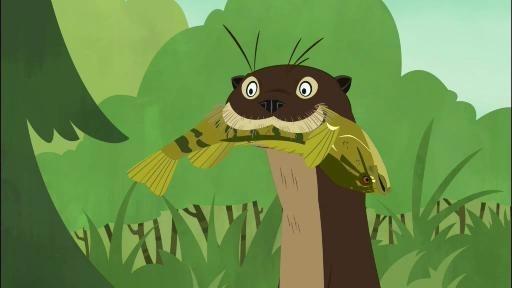I am tempted to tease the headline of this article as winning the prize for the single most consonance B’s ever in a beaver story, or mention that Capybara aren’t from Australia, but it’s a dam good article from a region where we have been short beaver support in the past. And authors don’t always get to pick the titles, and the paper is in Davis of all places. So I’ll politely refrain and just celebrate a wonderful article from our new best friend.
By Mary K. Hanson
Although some people consider them a pest species that causes temporary flooding of areas adjacent area to their home, the ever-active North American beavers (Castor canadensis) have actually been proved over and over again to be a boon to humankind in many ways.
In the past two or three years, projects and studies have been conducted throughout several Western states that conclusively prove that the beavers are actually 80 percent more effective (and less costly) at repairing and improving degraded stream systems than humans. And part of the reason for that is because the beavers instinctively know where the best places are to build their dams and lodges.
Beavers don’t kill the trees they harvest. Rather, they cut the trees down with their sharp incisor teeth to just above ground-level, leaving the root system entirely intact. In wildlife habitat restoration and management done by humans, this exact same process is call “coppicing.” The majority of coppiced trees don’t die; they instead grow new healthier shoots from the severed stump, providing for long-term regrowth and reforestation.
This is part of the reason why beavers are considered to be a “keystone species” in the environment: Their creation of new growth and water pathways and ponds actually increases the biodiversity in the areas in which they live.
What a great start! (Although I’m confused about the ‘past two or three years’ and think it’s been more like 2-3 decade.) But still. The article refers to Ms. Hanson as a ‘certified naturalist’ which I believe must mean that she completed the UCB program that our volunteers Deidre and Leslie did. Where means she studied with beaver guru Brock Dolman, which means she got an and unmitigated earful about the good work that Beavers do for us. Thank goodness. I love the idea of this article being printed in a paper from a region that depredates the second highest number of beavers in the state!
Studies have proved that where beaver dams are allowed to exist naturally, waterfowl and fish populations increase and become healthier and more diverse. In Washington state, for example, studies proved that beavers — which do not eat fish — were a benefit to local trout and salmon populations, increasing smolt production from about 15 individuals per range to 1,170 fish.
A similar effect on waterfowl diversity was seen in Wyoming, where it was shown that waterways where beavers were present resulted in a 75-percent increase in the number and diversity of ducks.
Other benefits afforded by beavers and their construction sites include:
* An increase in the variety of vegetation that enhances bird habitat;
* The removal of toxins from local waterways by filtering out sediments, phosphates and heavy nitrogen concentrations;
* A reduction in soil erosion, which can decrease flood dangers for people in surrounding areas;
* Helping to re-establish and increase riparian habitat, which also aids in the interception of runoff, increasing soil nutrients and providing habitat for a wide variety of plants and trees. Increased plant life has the added benefit of improving air quality as trees and plants naturally remove toxin form the air; and
* Because the dams slow down the flow of water near them they help to recharged spent aquifers (raising the level of water stored underground for use during drought conditions).
 Be still my heart! Ms. Hanson is a friend of ours even if we never met! I’m thinking the nonprofit she works with (TULEYOME) might want to come to the beaver festival! They have a shiny new website and obviously have lots to share. I think they’d enjoy themselves at the festival, don’t you?
Be still my heart! Ms. Hanson is a friend of ours even if we never met! I’m thinking the nonprofit she works with (TULEYOME) might want to come to the beaver festival! They have a shiny new website and obviously have lots to share. I think they’d enjoy themselves at the festival, don’t you?






 The Wetlands Conservancy and partners invite you to see nearly 100 artists at six different venues throughout 2017. These shows will highlight the Beaver, our natural ally in conserving Oregon’s wetlands and restoring natural systems.
The Wetlands Conservancy and partners invite you to see nearly 100 artists at six different venues throughout 2017. These shows will highlight the Beaver, our natural ally in conserving Oregon’s wetlands and restoring natural systems. in shaping our future as we prepare for the transformations that a warming and changing climate may bring. The Wetlands Conservancy is launching a statewide beaver conservation vision. Our goal is to learn more about how we can work with beaver to conserve and restore natural systems.
in shaping our future as we prepare for the transformations that a warming and changing climate may bring. The Wetlands Conservancy is launching a statewide beaver conservation vision. Our goal is to learn more about how we can work with beaver to conserve and restore natural systems.






 change. I can’t even claim they were informed by Jari’s awesome PBS documentary, since it aired before it. Please watch all the way through, and share with everyone you know. I wish we could play this at the beaver festival. It’s that good.
change. I can’t even claim they were informed by Jari’s awesome PBS documentary, since it aired before it. Please watch all the way through, and share with everyone you know. I wish we could play this at the beaver festival. It’s that good.





































